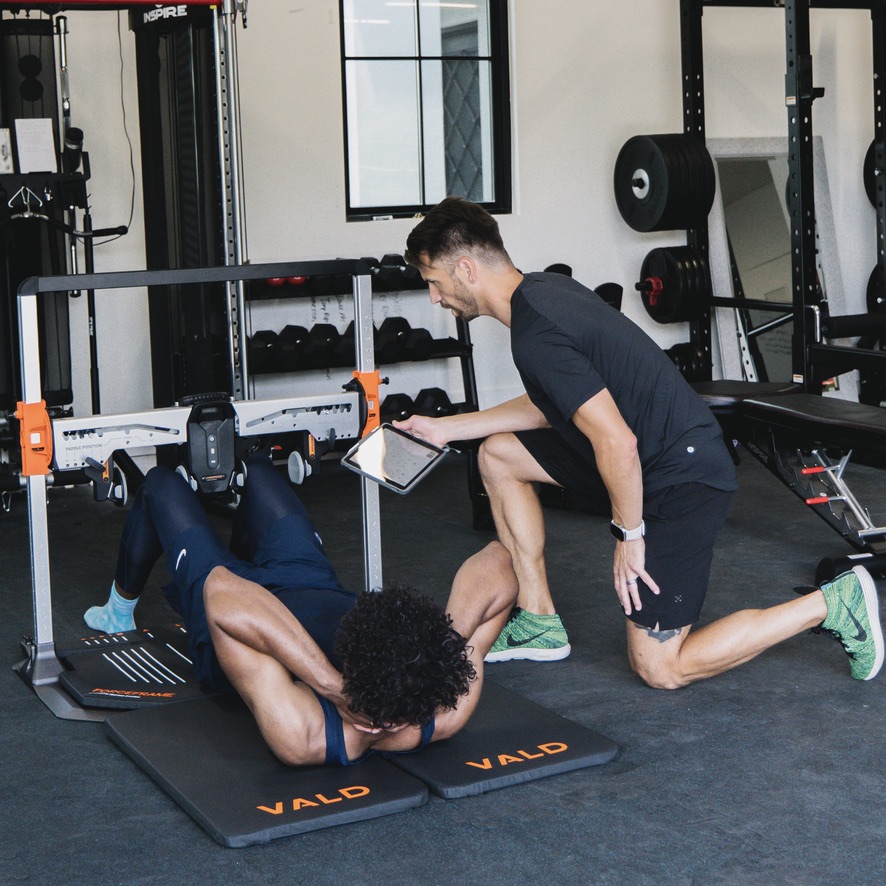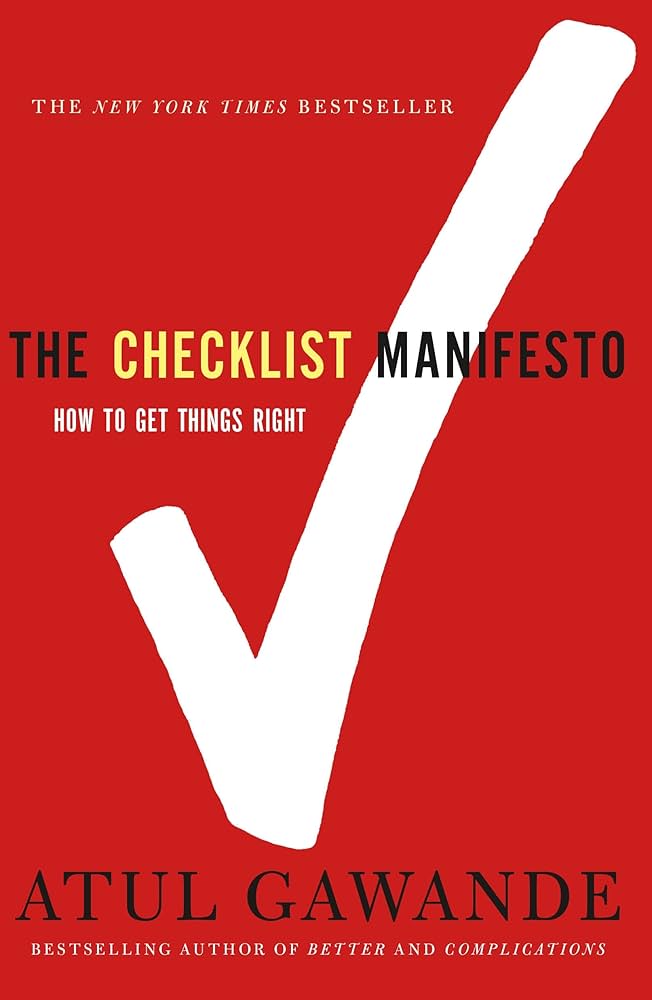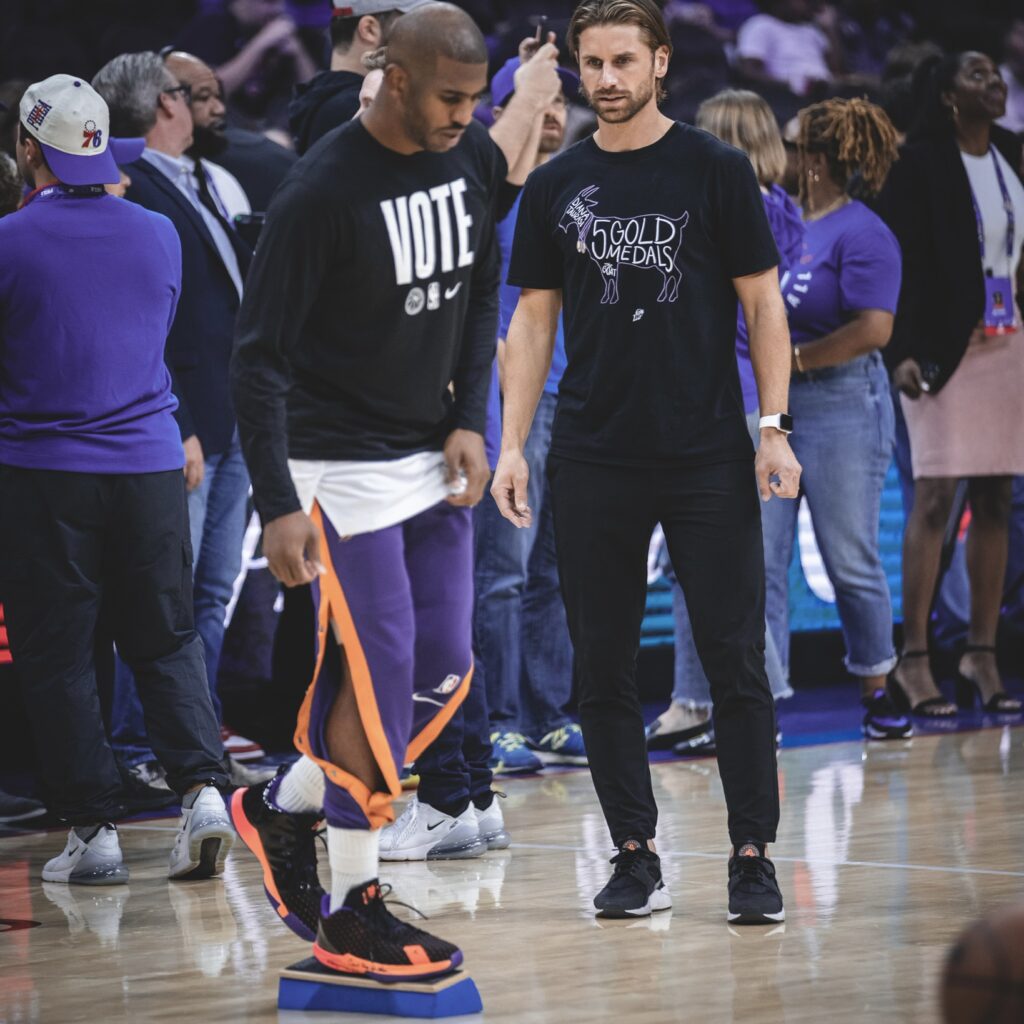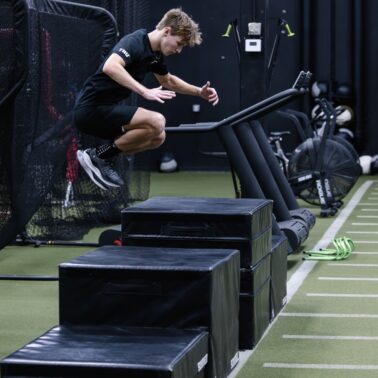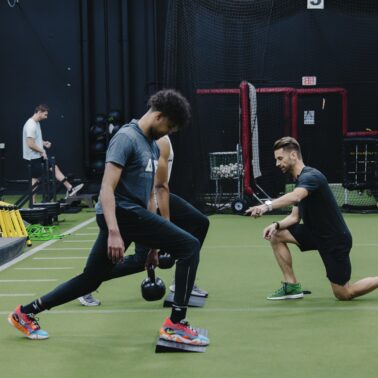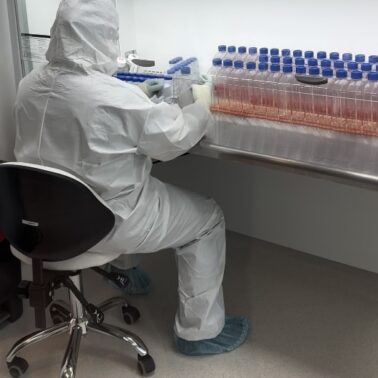Approximate Read Time: 9 minutes
“Normative data turns millions of test results into meaningful benchmarks that guide smarter, safer rehab and training decisions.”
What You Will Learn
- What normative data is and why it matters.
- Using checklists to direct priorities in rehab & training.
- How tech + AI are redefining “normal” in sport.
The Crossroads of Data, Tech, and Sport
In sports rehab and training, we are standing at a unique crossroads. For decades, practitioners made decisions based on observation, experience, and small research studies. Now, thanks to the convergence of big data, AI, and sports technology, we have something new: normative data.
Normative data is the aggregation of thousands — sometimes millions — of tests across populations, grouped by factors like age, sex, and sport. Instead of asking, “Is this athlete strong?” we can now ask, “How does this athlete compare to thousands of peers in their same sport and age group?” That context turns isolated numbers into actionable insights.
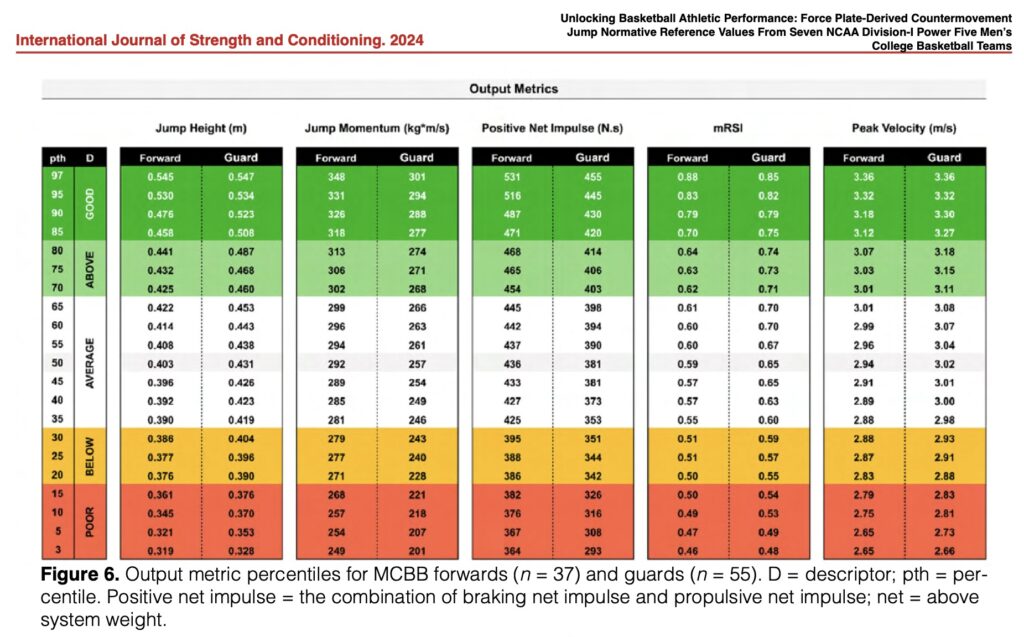
Think about how medicine has always used benchmarks. Blood pressure, cholesterol, and hemoglobin levels only make sense because we know what “normal” looks like across a population. Sports science is catching up. Platforms like Vald Performance have built massive real-time databases of strength, jump, and sprint data from athletes worldwide, giving coaches and clinicians the same kind of reference values physicians rely on in daily practice.
The result? Normative data offers not just numbers, but context — the difference between guessing and knowing whether an athlete is ready, at risk, or on track.
“Normative data is to performance what lab values are to medicine — context that turns numbers into meaning.”
Normative Data in Practice
Normative data is powerful because it anchors individual results within population standards. Instead of asking whether a single score is “good,” we can measure whether it is normal, below normal, or exceptional when compared to large databases or research cohorts.
Quadriceps Strength After ACL Reconstruction
A classic example is quadriceps recovery following ACL surgery. Research shows that even at nine months, many athletes still fall below sex- and graft-specific normative values for quadriceps strength (Schwery et al., 2022). These benchmarks help clinicians decide whether an athlete is actually ready to return, or simply “out of pain.”
The chart below highlights surgical limb vs. non-surgical limb for both male and female at intervals of 3, 6, and 9 months. The metric is derived from isokinetic testing and is normalized to bodyweight. As a general standard, I prefer to see the male athlete at 3.0x bodyweight for quadriceps strength.
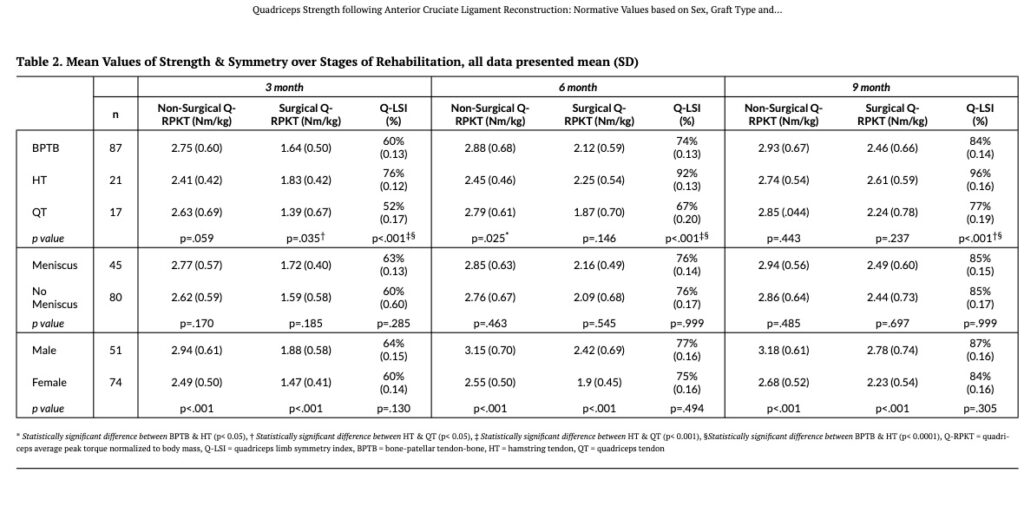
Cardiorespiratory Fitness and Longevity
Fitness isn’t just about sport performance — it’s about survival. In a cohort of over 120,000 patients, elite levels of cardiorespiratory fitness (CRF) were associated with an 80% lower risk of all-cause mortality compared to low CRF groups (Mandsager et al., 2018). VO₂max values now serve as both a performance metric and a predictor of healthspan.
Intuitively we have known that the more fit athletes get injured less than the unfit athletes. With the growing interest in in longevity medicine, we can leverage the same data from the general public and apply it to the athletic community. The below table highlights age, gender, and performance group measure in METs (metabolic equivalents). Simply multiply the value from the chart by 3.5 to obtain a rough estimate of VO2max.
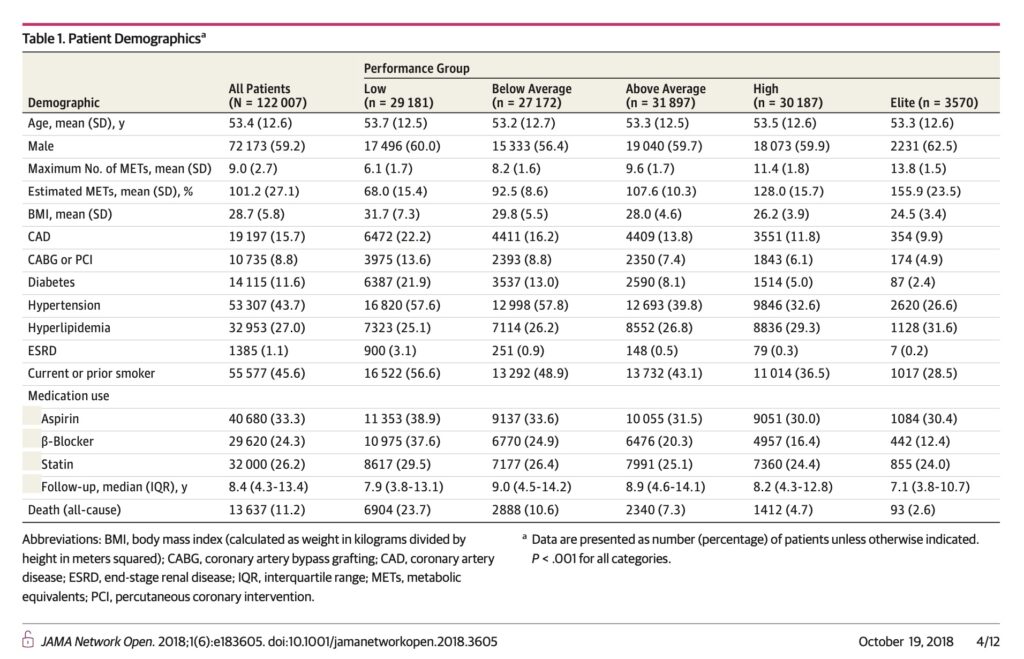
Body Composition Norms
DEXA scans give us a clear picture of lean mass distribution. Normative cut-offs for appendicular lean mass — such as <7.25 kg/m² in men — flag sarcopenia risk, even in active adults (Imboden et al., 2017). These values help distinguish between “fit-looking” athletes and those truly prepared to meet performance demands.
Again, leaner athletes often get injured less in comparison to less lean athletes. Obesity and overweight individuals are usually more prone to illness and disease in comparison to those who are at a more appropriate weight. We can link longevity and healthspan to injury risk and performance leveraging the same information.
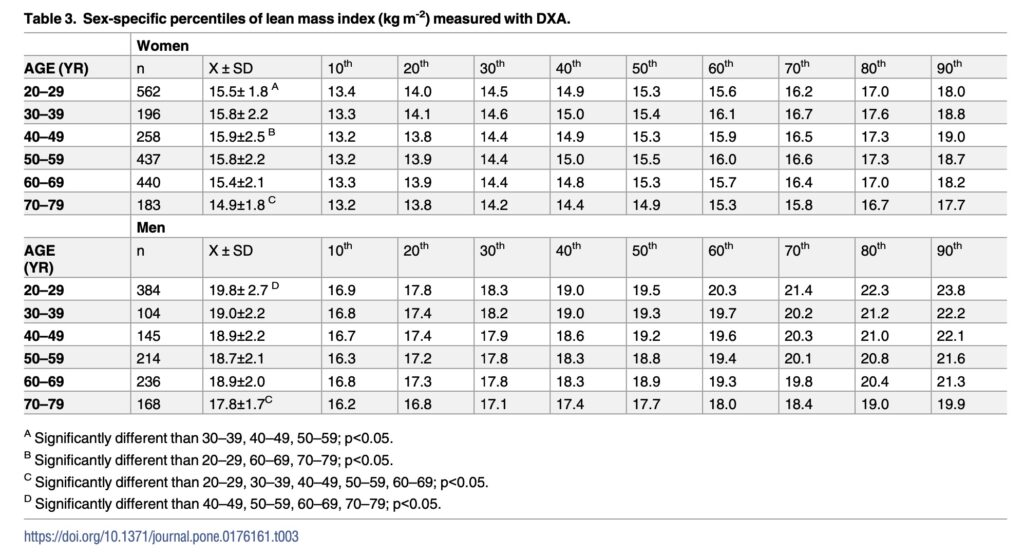
Relative Squat Strength
Strength benchmarks also carry predictive value. Collegiate athletes with squat relative strength below 2.2× bodyweight (men) or 1.6× (women) were more likely to suffer lower extremity injuries in-season (Case et al., 2020). A single number — normalized to body mass — becomes a screening tool for resilience.
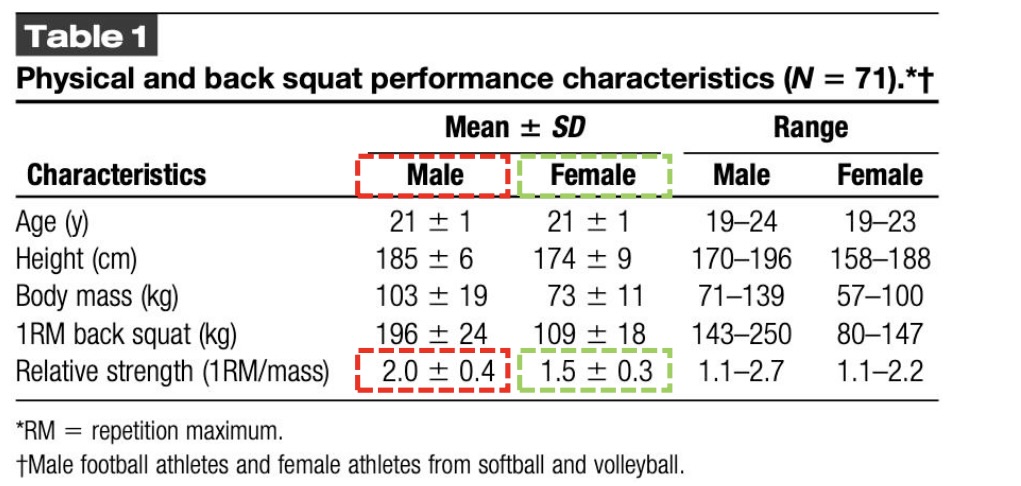
Workload and Injury Risk
Normative workload data also shapes injury risk conversations. Athletes with higher baseline strength and speed are better able to tolerate spikes in weekly training loads compared to weaker or slower peers (Malone et al., 2018). Norms for speed over 5–20 m and repeated-sprint ability stratify risk across athletes in the same sport.
Together, these examples highlight how normative data gives context to numbers that might otherwise sit in isolation. Without standards, a quadriceps strength test or a jump height is just a number. With them, it becomes a roadmap.
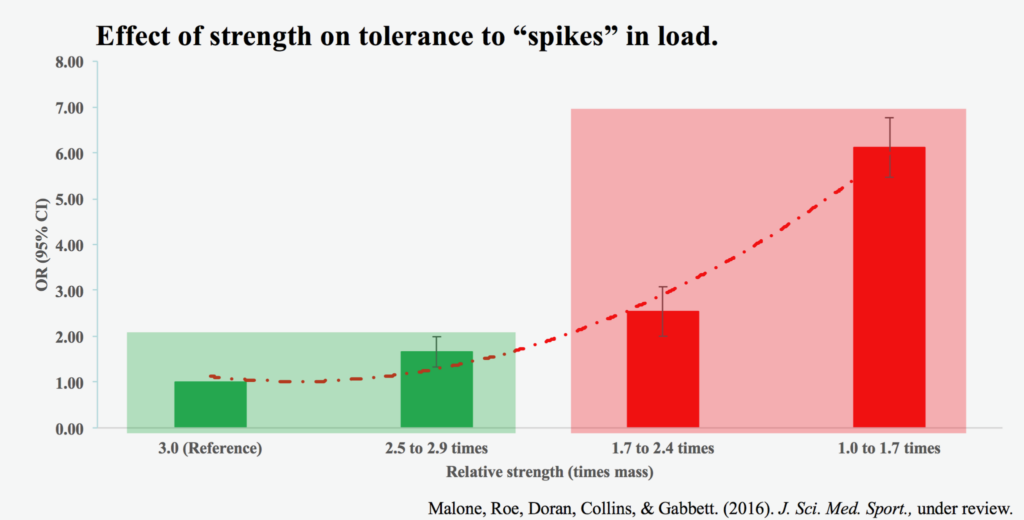
The 3P Framework: Principles and Normative Data
“Normative data turns test scores into road signs — showing who’s ready, who’s at risk, and who needs more work.”
Normative data is most valuable when it connects to a bigger framework. Within the 3P Model — Principles, Process, and Plans — the first three principles are Movement, Fitness, and Force. These are the foundation of rehab and training, and each now has normative anchors that give us clearer standards than ever before.
Movement: Asymmetries and Postural Norms
Historically, “movement screens” were interpreted subjectively: is this athlete stiff, stable, or symmetrical? Today, platforms like Vald’s HumanTrak and DEXA scans quantify those same questions. For example, hip or hamstring asymmetries greater than 10% are often flagged as red lights. These values help us decide if movement inefficiencies are just quirks or meaningful risks.
Fitness: Cardiorespiratory Benchmarks
Fitness is often the missing link in return-to-play decisions. Normative VO₂max standards and maximal aerobic speed values give us objective thresholds for both health and performance. Research shows higher fitness not only improves sport outcomes, but is one of the strongest predictors of longevity (Mandsager et al., 2018). When fitness falls below expected ranges for age and sex, injury risk climbs (Malone et al., 2018). Norms provide a clear line between “fit enough to compete” and “not yet resilient.”
Force: Strength and Power Standards
Force is the foundation of performance (F = M*A). Normative standards now define “how strong is strong enough.” Collegiate athletes below 2.2× bodyweight squat (men) or 1.6× (women) face higher seasonal injury rates (Case et al., 2020). Jump metrics tell a similar story: counter-movement jump (CMJ) heights and reactive strength indexes (RSI) from NCAA datasets provide sport-specific averages. These benchmarks not only measure capacity but also resilience under load.
By aligning Movement, Fitness, and Force with population-based standards, the 3P Framework shifts from abstract ideas to measurable checkpoints. What once relied on “it depends” is now guided by thresholds grounded in evidence.
The Process: Checklists and Decision-Making
Principles give us the “what.” Process tells us the “how.” In the 3P Framework, Process is where normative data comes alive — turning abstract benchmarks into decision-support tools.
Atul Gawande’s Checklist Manifesto argued that complex environments demand simple, repeatable systems. Surgery, aviation, and construction all rely on checklists to ensure critical steps aren’t missed. Sports rehab and training are no different. Normative data provides the raw material to build those checklists.
How It Works in Rehab
Imagine an athlete six months post-ACL reconstruction. Without benchmarks, the decision to progress is subjective: “They look strong.” With normative data, the process is clearer: quadriceps strength <2.5 Nm/kg is a red flag (Schwery et al., 2022). A checklist built from this data highlights what must improve before sprinting or cutting drills are introduced.
How It Works in Training
Take preseason testing. If a soccer player’s countermovement jump height is below NCAA Division I averages, while their aerobic fitness is in the 90th percentile, the checklist prioritizes force production over conditioning. This doesn’t mean conditioning is irrelevant — it means resources are directed where they’ll have the most impact.
Why Checklists Matter
Normative checklists do three things:
- Simplify complexity — turning data points into a clear “yes/no” guide.
- Direct resources — showing coaches where to invest time (strength vs. conditioning vs. mobility).
- Improve communication — giving athletes objective milestones instead of vague feedback like “you’re getting better.”
When data informs the process, “it depends” is no longer an excuse. Instead, progress is measured against transparent, evidence-based standards.
“Normative data transforms testing into a checklist — highlighting what matters most for rehab and training decisions.”
Context Creates Clarity
In rehab and training, raw numbers can be misleading. A squat max, VO₂ score, or jump height doesn’t mean much until it’s compared against standards. Normative data provides that context — transforming test results into meaningful insights about readiness, risk, and resilience.
Through the 3P Framework, normative values anchor the principles of Movement, Fitness, and Force. The Process uses those benchmarks like a checklist, guiding therapists and coaches toward the right priorities and away from guesswork. And in practice, these standards clarify communication: athletes see where they stand not just against themselves, but against their sport.
The future is even brighter. With expanding datasets, smarter AI tools, and real-time integration from platforms like Vald, normative data will only grow sharper and more actionable. Numbers alone don’t win games or prevent injuries — but numbers in context can support player availability.
The Fab Five: Key Takeaways
- Normative data gives context: Benchmarks make strength, fitness, and movement scores meaningful.
- Big data meets sport: Platforms like Vald aggregate millions of results into real-time standards.
- 3P alignment: Movement, Fitness, and Force each now have population-based benchmarks to guide progress.
- Checklists drive process: Borrowing from medicine, normative values help prioritize training and rehab focus.
- Future is AI-driven: Larger datasets and smarter systems will refine how we individualize rehab and training.
Free Download
Read More Like This
Related Podcasts
References
Case, M. J., Knudson, D. V., & Downey, D. L. (2020). Barbell squat relative strength as an identifier for lower extremity injury in collegiate athletes. Journal of Strength and Conditioning Research, 34(5), 1249–1253.
Imboden, M. T., Swartz, A. M., Finch, H. W., Harber, M. P., & Kaminsky, L. A. (2017). Reference standards for lean mass measures using GE dual energy x-ray absorptiometry in Caucasian adults. PLOS ONE, 12(4), e0176161.
Malone, S., Hughes, B., Doran, D. A., Collins, K., & Gabbett, T. J. (2018). Can the workload–injury relationship be moderated by improved strength, speed and repeated-sprint qualities? Journal of Science and Medicine in Sport, 21(12), 1274–1278.
Mandsager, K., Harb, S., Cremer, P., Phelan, D., Nissen, S. E., & Jaber, W. (2018). Association of cardiorespiratory fitness with long-term mortality among adults undergoing exercise treadmill testing. JAMA Network Open, 1(6), e183605.
Schwery, N. A., Kiely, M. T., Larson, C. M., Wulf, C. A., Heikes, C. S., Hess, R. W., Giveans, M. R., Solie, B. S., & Doney, C. P. (2022). Quadriceps strength following anterior cruciate ligament reconstruction: Normative values based on sex, graft type and meniscal status at 3, 6 & 9 months. International Journal of Sports Physical Therapy, 17(3), 434–444.
